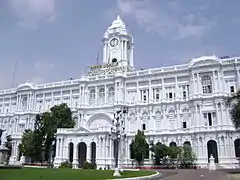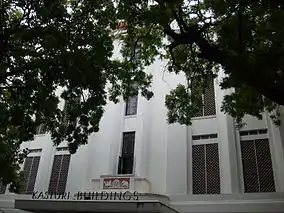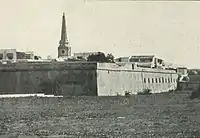Heritage structures in Chennai
Chennai, with historically rich records dating from the British era, houses 2,467 heritage buildings within its metropolitan area (CMA), the highest within any Metropolitan Area limit in India.[1] Most of these buildings are around 200 years old and older. Some of them are Chennai Central, Chennai Egmore, Ripon Building, Senate House, Bharat Insurance Building, and so forth.[2] Chennai is home to the second largest collection of heritage buildings in the country, after Kolkata.[3] The official list of heritage buildings was compiled by the Justice E. Padmanabhan committee.[4]
The structures will be categorised into three grades, namely, Grades I, II, and III. Grade I structures will be prime landmarks upon which no alterations will be permitted. Under Grade II, external changes on structures will be subject to scrutiny. Buildings under Grade III may be changed for 'adaptive reuse' with suitable internal and external changes.[5]
Heritage activism
Heritage buildings are defined as notified structures of historical, architectural, or cultural significance.[5] The heritage activism in the city began with the erstwhile Moore Market building fire in 1985.[6] In 1997, the state government initiated action to conserve heritage buildings. In 1998, a committee headed by Director of Town and Country Planning was constituted by the government to investigate aspects related to enactment of the Heritage Act.[7] In 1999, the committee submitted the draft of Tamil Nadu Heritage Conservation Act. In the same year, Chennai Metropolitan Development Authority (CMDA) constituted a Heritage Conservation Committee to draft regulations to conserve heritage buildings and precincts in the Chennai Metropolitan Area (CMA).[7] After the second master plan for the city was approved by the government on 2 September 2008, special rules for conservation of heritage buildings/precincts came into force.[5] In 2010, the criteria for listing the heritage structures in the CMA region was finalised, and in 2011, the process of assessment and documentation of heritage structures began.[7] A 17-member Heritage Commission was set up on May 2012 to maintain these structures, after a fire accident in Kalas Mahal, a 244-year-old heritage building in front of Marina beach.[8] As per the Commission's mandate, heritage buildings that are listed will get incentives, such as exemption from payment of taxes, and offenders who deface or destroy them will face penal action.[1]
In 2012, a list of heritage buildings was released by the Chennai Metropolitan Development Authority (CMDA) under the heritage conservation committee's (HCC) supervision. Criteria considered for notification as heritage structure include period of construction, exhibited trend, events or persons associated with the structure, and design, style, designer, physical condition, and design integrity for architecturally significant buildings.[5] The CMDA was expected to clear the first list of 70 heritage buildings compiled by the HCC. However, in 2013, the process of notification was delayed after 65 owners objected to the inclusion of their premises in the list. The Heritage Conservation Committee, however, overruled their objections.[7] Of the structures/precincts that figure on the list, 42 are government buildings and the remaining are private ones. The government buildings include the main building of the College of Engineering Guindy under Anna University, Madras High Court, General Post Office, Music and Dance College, Saidapet Teachers' College and King Institute of Preventive Medicine. Theosophical Society is one of the private premises that are expected to get listed as a heritage structure. When a building is notified as a heritage structure, the onus of repair and maintenance of the heritage structure will be on the structure's owner.[5] In July 2018, documentation of the last phase covering 192 of the 467 buildings listed by Justice E. Padhmanaban Committee began.[7]
Grading of heritage structures
The heritage structures have been classified into three grades, viz. Grade I, II, and III. Grade I includes buildings and precincts of national or historical importance, with excellence in architecture, style and design. These structures remain the chief landmarks of the city. Save for some minimal changes approved by the Heritage Conservation Committee (HCC), no intervention, both on the interior and on the exterior, will be permitted in these structures. Grade II includes those structures of regional or local importance with special architectural or aesthetic merit, cultural or historical value. Although internal changes to the structures and adaptive reuse are allowed, here, too, external changes are allowed after scrutiny by the HCC. Extension or construction of additional buildings in the same plot are permissible as long as they are in harmony with the existing structure, especially in terms of facade and height. Grade III includes structures of importance for town spaces. These structures evoke architectural or aesthetic interest, but not as much as the Grade II structures. Changes to both external and internal portions of the buildings are generally permissible for Grade III buildings.[7]
Structures listed by the HCC
Prominent buildings on the HCC's list include:
- Madras High Court
- Anderson Church, Parry's
- Church of Our Lady of Light (Luz Church), Mylapore
- General Post Office, Rajaji Salai
- Royapuram Railway Terminal
- Theosophical Society Headquarters Building, Besant Avenue, Besant Nagar
- City Civil Court Building, NSC Bose Road, Park Town
- Madras Engineering College (Main Building), Anna University, Sardar Patel Road, Guindy
- Bharathiyar Illam, Triplicane
- Madras Club (Moubray's Cupola), Adyar Club Gate Road
Structures that remain to be documented include:
- Loyala College, Nungambakkam
- Horticultural Society, Cathedral Road
- Royapuram Clock Tower
- The Hindu, Anna Salai
- Kamarajar Arangam, Anna Salai
- Department of Public Instruction, College Road
- Panagal Park, T. Nagar
- Royapettah Clock Tower
- Music Academy, TTK Road
- CSI School of the Deaf, Santhome High Road
Buildings on the heritage list that do not exist any more include:
- Chennai Central Prison, Park Town
- Old Sacred Heart Shrine, Pantheon Road
- Roxy Theatre, Purasawalkam High Road
- Old Jail, Prakasam Road
- Old building of Kalaivanar Arangam, Wallajah Road
List of heritage structures
| S.No | Building | Architectural style | Year of construction |
Architect | Neighborhood | Notes | Image |
|---|---|---|---|---|---|---|---|
| 1. | Chennai Central railway station | Gothic Revival | 1873 | George Harding | Park Town | Built as a second terminus to decongest the Royapuram harbour station, which was being utilised for port movements. Built in a combination of styles, namely, Gothic and Romanesque.[9] |  |
| 2. | Southern Railway headquarters | Indo-Saracenic | 1921 | N. Grayson | Park Town | Originally built as the new Madras and Southern Mahratta Railway Company (MSMR) headquarters (successor of Madras Railway Company), replacing the general office of MSMR at Royapuram Railway Station. Built for the first time in India in reinforced concrete in classical and Dravidian styles.[10] |  |
| 3. | General Post Office | Victorian County-Colonial | 1884 | Robert Fellowes Chisholm | George Town | Built at a cost of ₹ 680,000.[11] |  |
| 4. | Madras High Court | Indo-Saracenic | 1892 | J. W. Brassington, Henry Irwin | George Town | The court buildings are believed to be the second largest judicial complex in the world after the one in London. The complex also houses the largest number of courts in Asia.[12][13][14] |  |
| 5. | Bharat Insurance Building | Indo-Saracenic | 1897 | Anna Salai | Originally known as Kardyl Building | ||
| 6. | Chepauk Palace | Indo-Saracenic | Around 1764 | Chepauk | The official residence of the Nawab of Arcot from 1768 to 1855 |  | |
| 7. | Senate House, University of Madras | Indo-Saracenic | 1879 | Robert Fellowes Chisholm | Chepauk | Incorporates many elements of the Byzantine style.[15] The great hall of the Senate House is of immense height and proportions, considered to be the finest of its kind in India.[15][16] |  |
| 8. | College of Engineering | Indo-Saracenic | 1920[17] | Guindy | Designed by consulting architect W. H. Nicholls and later by chief engineer F. J. Wilson.[18] |  | |
| 9. | Government Museum Buildings | Indo-Saracenic | between 1789 and 1890 | Henry Irwin | Egmore |  | |
| 10. | National Art Gallery | Indo-Saracenic | 1906 | Henry Irwin | Egmore |  | |
| 11. | Egmore Railway Station | Indo-Saracenic | 1908 | Henry Irwin | Egmore |  | |
| 12. | Ripon Building | Indo-Saracenic | 1913 | G.S.T Harris | Park Town | Built at a cost of ₹ 750,000. |  |
| 13. | Victoria Public Hall | Indo-Saracenic | 1888-1890 | Robert Fellowes Chisholm | Park Town | The venue of the first cinema show in Chennai. |  |
| 14. | The Mail | Anna Salai |  | ||||
| 15. | P Orr & Sons | Anna Salai | .jpg.webp) | ||||
| 16. | The Hindu | Anna Salai |  | ||||
| 17. | Christ Church | Anna Salai | Possibly the first congregation outside Fort St George. | ||||
| 18. | Suguna Vilasa Sabha | Anna Salai | Possibly one of the earliest drama theatres with stalwarts like Pammal Sambanda Mudaliar — now called SVS Club. | ||||
| 19. | Dargha of Sufi Saint Syed Moosa Sha Khaderi | 17th century | Anna Salai |  | |||
| 20. | Gove Building (formerly Cuddon Building) | Anna Salai | .jpg.webp) | ||||
| 21. | Higginbotham's | 1844 | Abel Joshua Higginbotham | Anna Salai | The first and the oldest existing book shop in India. |  | |
| 22. | King Institute of Preventive Medicine and Research | 1899 | Anna Salai, Guindy | ||||
| 23. | Royapuram railway station | 1853 | Royapuram | Designed by William Adelpi Tracey.[18] Third oldest railway station in the country and the oldest in South India.[19] |  | ||
| 24. | Fort St. George | 1640 | George Town | First major British settlements in India, leading to the foundation of the city of Madras. One of the 163 notified areas (megalithic sites) in the state of Tamil Nadu.[20] |  | ||
| 25. | Police headquarters | 1839 | Mylapore | Renovated in 1993.[21] | |||
| 26. | Amir Mahal | Indo-Saracenic | 1798 | Royapettah | .jpg.webp) | ||
| 27. | State Bank of India Building | Victorian Architecture | 1897 | Col. Samuel Jacob | George Town |  | |
| 28. | Dobbin Hall | 1904–05 | Madras Veterinary College (now located opposite) started functioning. | ||||
| 29. | Government College of Fine Arts and Crafts | Indo-Saracenic | 1850 | Robert Fellowes Chisholm | Egmore | The first school of arts in Asia | |
| 30. | Madras Record Office | Indo-Saracenic | 1909[22] | G. S. T. Harris | Egmore | Currently known as Tamil Nadu Archives/Department of Archives & Historical Research | |
| 31. | St Andrew's Church | Georgian church architecture | 1821 | Major De Havilland | Egmore | Built at a cost of 20,000 UK pounds |  |
| 32. | Government Central Press | 1807 | George Town | ||||
| 33. | Deputy Inspector General of Registration | 1880 | George Town | Housed registration department offices. Spread over 20,000 sq ft.[23] | |||
| 34. | Kilpauk Water Works | 1914 | Kilpauk | First water treatment facility with 80 mld capacity.[24] | |||
| 35. | Red Fort building at the Madras Medical College | 1897 | Park Town | [25] | |||
| 36. | Egmore Eye Hospital | 1819 | Egmore | ||||
| 37. | Egmore Court Complex | 1916 | Egmore | Indo-Saracenic style of architecture. Spread over 8,640 square feet, it housed the Chief Metropolitan Magistrate Court, three additional Chief Metropolitan Magistrate courts and 10 magistrate and fast track courts. Restored in 2018 at a cost of ₹ 48 million. The same year, a new 6-storied 71,200-square-feet building, with 12 court halls, was constructed at the premises as additional court complex.[26] | |||
| 38. | Bharathi Illam | Triplicane |  |
References
- Mariappan, Julie (10 July 2012). "Long history of service". the hindu. Chennai: the hindu. Retrieved 12 November 2012.
- Heritage building gets a breather
- Ravishankar, Sandhya (6 September 2007). "No fire safety norms at Chennai heritage buildings". IBN Live. Chennai: CNN IBN. Retrieved 20 November 2012.
- Ravi, Bhama Devi (18 April 2012). "Tamil Nadu's shameful disregard for heritage buildings". Sify News. Chennai: Sify News. Retrieved 12 November 2012.
- Xavier Lopez, Aloysius (6 February 2013). "42 government buildings among 70 vying for heritage status". The Hindu. Chennai: The Hindu. Retrieved 11 February 2013.
- Sriram, V. (10 October 2008). "To market, to market..." India Today. Chennai: India Today. Retrieved 29 November 2012.
- "Conserving Chennai's Past". The Hindu. Chennai: The Hindu. 3 July 2018. Retrieved 15 July 2018.
- Srivathsan, A (19 September 2013). "Heritage commission remains on paper". The Hindu. Chennai: The Hindu. Retrieved 20 September 2013.
- Kurian, Nimi (18 August 2006). "Long history of service". The Hindu. Chennai: The Hindu. Retrieved 3 November 2012.
- Venkataraman, G.; A. Anne Shanthi. "History of Historical Building and Monuments in and around Chennai" (PDF). CMDA Chennai. Retrieved 10 May 2012.
- Muthiah, S. (30 October 2011). "Madras miscellany — The Madras G.P.O. beginnings". The Hindu. Chennai: The Hindu. Retrieved 10 March 2012.
- "Madras High Court". BSNL. Archived from the original on 30 January 2012. Retrieved 2 March 2012.
- "High Court Building". CHENNAI-DIRECTORY.COM. Archived from the original on 5 June 2013. Retrieved 2 March 2012.
- Chandru, K. (26 November 2011). "Some thoughts around the Madras High Court". The Hindu. Chennai: The Hindu. Retrieved 27 November 2011.
- Srinivasachari, Introduction, p 262
- Srinivasachari, Introduction, p xxxiv
- Parthasarathy, Anusha (29 November 2011). "Survivors of time – College of Engineering (Guindy)". The Hindu. Retrieved 28 July 2018.
- http://www.cmdachennai.gov.in/pdfs/seminar_heritage_buildings/History_of_Historical_Monuments_in_and_around_Chennai.pdf
- "Third oldest railway station in country set to turn 156". Deccan Chronicle. Chennai: Deccan Chronicle. Archived from the original on 29 June 2012. Retrieved 27 June 2012.
- Madhavan, D. (20 December 2012). "National Institute of Siddha modifies expansion plan". The Hindu. Chennai: The Hindu. Retrieved 23 December 2012.
- Iyengar, Pushpa (2 June 2008). "Cornered Stones". Outlook India. Outlook India.com. Archived from the original on 19 February 2011. Retrieved 19 May 2012.
- http://www.tnarchives.tn.gov.in/aboutus.html
- K., Lakshmi (13 December 2017). "3 historic buildings to rise from the ruins". The Hindu. Chennai: Kasturi & Sons. p. 2. Retrieved 17 December 2017.
- "Kilpauk water works facility goes hi-tech". The Hindu. Chennai: Kasturi & Sons. 18 December 2017. Retrieved 7 January 2018.
- Josephine M., Serena (1 August 2018). "'Red Fort' at Madras Medical College to reopen as museum". The Hindu. Chennai: The Hindu. Retrieved 5 August 2018.
- Lakshmi, K. (2 March 2018). "New court complex in Egmore will be ready by month-end". The Hindu. Chennai: The Hindu. Retrieved 19 August 2018.